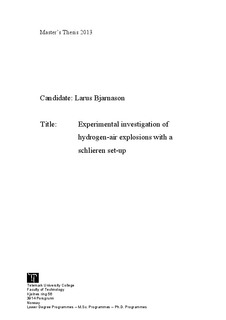| dc.contributor.author | Bjarnason, Larus | |
| dc.date.accessioned | 2015-09-18T12:02:51Z | |
| dc.date.accessioned | 2017-04-19T13:18:01Z | |
| dc.date.available | 2015-09-18T12:02:51Z | |
| dc.date.available | 2017-04-19T13:18:01Z | |
| dc.date.issued | 2015-09-18 | |
| dc.identifier.citation | Bjarnason, L. Experimental investigation of hydrogen-air explosions with a schlieren set-up. Master thesis, Telemark University College, 2013 | |
| dc.identifier.uri | http://hdl.handle.net/11250/2439021 | |
| dc.description.abstract | Schlieren has been used in the visualization of shock waves since the beginning of the 20th century and is still highly actual in the research of shock waves and DDT. The goal of this study was to build a schlieren setup to use in high speed photography of hydrogen and air explosions in a channel with one obstacle in order to photograph deflagration to detonation transition. A 3 meter long open-ended test channel with one obstacle and closed in the end of ignition with cross-section of 0.1x0.1 m was used. The channel was filmed with a high-speed camera at three different positions all after the obstacle with pressure recordings at different position in the channel. The results from experiments with mixtures of 25%vol. H2 to 35%vol. H2 and blockage ratio of 0.75 are presented in this report with pressure recordings and schlieren photos. Detonation occurred in mixtures from 28 to 35%vol. H2. Shock waves were observed for all mixtures at various distances from the obstacle and DDT was seen in two tests with 30%vol. H2 at a distance between 0.4 and 0.45 m from the obstacle. The run-up distance is observed to be shorter as the mixtures get richer, this is observed from both the schlieren photographs and the pressure recordings. The shock wave velocities were estimated from the pressure recordings and for mixtures that detonated they are above the CJ-velocity in all cases. The flame velocities were estimated from the photographs for two tests that detonated and in both cases were about 40% of the CJ-velocity. The schlieren setup was successful in the way that it was able to make photographs of well observable shock waves along with the deflagration to detonation transition, however further experiments are recommended with higher frame rate to gain understanding of the DDT phenomena. | |
| dc.language.iso | eng | |
| dc.publisher | Høgskolen i Telemark | |
| dc.subject | Schlieren | |
| dc.subject | Shock wave | |
| dc.subject | Hydrogen | |
| dc.subject | Explosion | |
| dc.title | Experimental investigation of hydrogen-air explosions with a schlieren set-up | |
| dc.type | Master thesis | no |
| dc.description.version | Published version | |
| dc.rights.holder | © Copyright The Author. All rights reserved | |
| dc.subject.nsi | 562 | |
